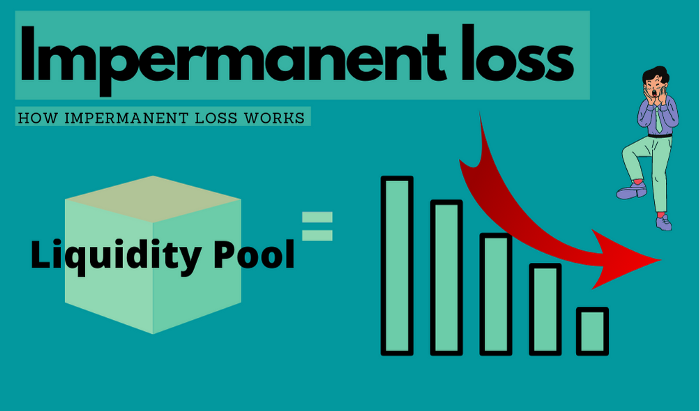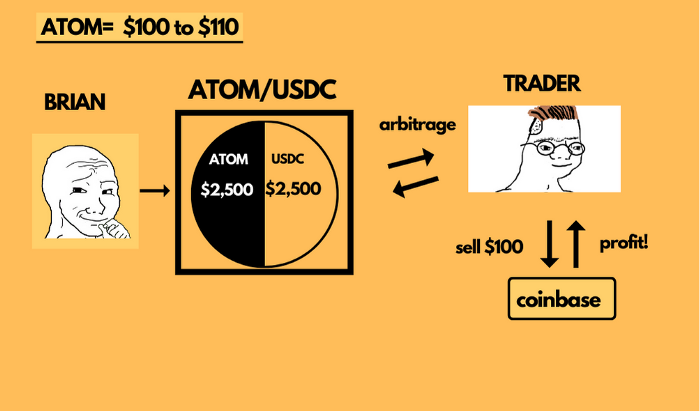A liquidity provider’s simple guide to impermanent loss.
Impermanent loss is a concept that everyone who puts money into a liquidity pool should know.
If you’ve read my liquidity pool guide, you’d know that it’s an inherent risk that comes with being a liquidity provider and that there are strategies that can reduce or even avoid losses for liquidity providers.

To simplify it, Impermanent loss is this:
It is when you provide liquidity to a liquidity pool (paired token) in which one or both token pairs experience a sudden change in price leading to a temporary loss while providing to the pool instead of just simply holding the token.
To clarify, you have profited, but you would have made a lot more by simply holding the token.
You will experience impermanent loss commonly through these 3 scenarios:
- If one token‘s price increases while the other stays the same
- If one token’s price decreases while the other stays the same
- If one token’s price increases while the other decreases

How does impermanent loss happen?
This is best explained through a scenario:
Liquidity pools are found in Decentralized Exchanges (DEXs) like Osmosis or Uniswap. Two key players come into play with impermanent loss: trader & liquidity provider.
Liquidity providers provide liquidity to an LQ (liquidity pool). These pools maintain a 50:50 ratio, which means the paired tokens are of the same price/value. It’s also important to note that liquidity pools are possible due to AMMs (Automatic Market Makers). It’s best explained in an article for itself, but just know that it’s a type of program that helps automate the process of trading. It effectively removes the hassle of matching buyers with sellers, automating the process to peer-to-contract instead of peer-to-peer
Here is the scenario:

Brian provided to the ATOM/USDC pool over at app.osmosis.com with a total of $5,000. With a 50:50 ratio that would be $2,500 for each token. Let’s say that the price of 1 ATOM is worth $100. You’ve got 25 ATOM & 2.5k dollars on your liquidity pool.

If the price of 1 ATOM suddenly went up to $110. A trader then sees that he can buy cheaper ATOM at your pool for $100 which he could sell to apps like Coinbase or Binance for the price of $110.
This is called an arbitrage trade or arbitrage opportunity for the trader.
So what happens next is that the trader would arbitrage until the pool would automatically fix its price (until the pool’s atom price goes up to $110).
Simply put, you would still gain tremendously when the price increases. But due to inherent mechanisms that keep a Decentralized exchange stable, you would have made more if you just simply held the token.
Sounds scary. So do I avoid liquidity pools?
There’s no cause for alarm, liquidity pools are still quite profitable due to trading fees & impermanence.
Trading Fees
- Trading fees often offset the loss you lose when providing liquidity. Remember that while you provide liquidity, you gain yields according to the APR of the liquidity pool.
Impermanence?
- Impermanence in impermanent loss means that the loss is actually temporary. It only becomes permanent when you cash out your assets. Liquidity providers often wait until the loss offsets before they cash out to maximize profits.

Strategies for avoiding impermanent loss
Liquidity providers develop their own strategies for avoiding impermanent loss. These are the common strategies that I have observed in the fray.
Providing to a Stablecoin liquidity pair
- Providing liquidity that is paired to a Stablecoin pair minimizes losses since Stablecoins are tied to real-world assets like the US dollar.
- There are conservative dual stable pair pools that are relatively safe compared to other assets as both stables are tied to each other provided that you are fine with a low-interest but safe investment.
Providing liquidity to solid bluechip assets
- Another method is investing in pools with solid token pairs that are not as volatile as the others
- Liquidity providers often see Ethereum or Bitcoin as a solid blue-chip assets so if you want relatively involatile assets opt for blue-chips
Diversifying your tokens
- There are liquidity pools that provide more than 2 assets. Providing these might minimize losses.
- You could also provide across many pools rather than betting your gains on a single liquidity pool.










